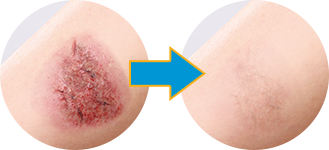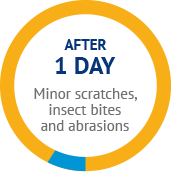"Don't worry, it will fade away with time." We've all heard this every time we get a scar, but is there any truth to it?
As explained in detail in our other article, scars are the result of our skin closing a wound by filling it up with fibrous collagen tissues that are formed with much less care than normal skin, which is carefully woven together.1
After a scar is first formed, the body continues to touch up its work where it can - which is why scars fade slightly over the years when left alone. But scar tissue does not get replaced by this process2, which means that most scars, when left to heal naturally, will never fully disappear. That's why it is important to apply scar treatments such as Dermatix® Ultra.
Can scars be fully removed by treatments?
Surgical Scar
Photos courtesy of Dr Kim Yong Oock (Plastic Surgeon, Korea)
Before
Clearly visible dark scar
After (Dermatix® Ultra)
Barely noticeable lightened scar

Burn Scar
Before
Clearly visible dark scar
After (Dermatix® Ultra)
Barely noticeable lightened scar

For maximum effectiveness, you should treat the scar once it is formed. This is because Dermatix® Ultra works by supporting your body's natural healing processes, which happen mostly during the first two years of scar formation.
By applying Dermatix® Ultra while the scar is still fresh, it will be able to achieve the greatest scar reduction effect. Here’s a rough guide on how soon you can begin scar management after your injury!




Scar recovery days
Start of Dermatix® Ultra treatment
Note: These are general guidelines, always ensure that your wound has healed and your skin is dry and intact; and if you have surgical stitches, wait until they have been removed before starting treatment with Dermatix® scar treatments.
Whether your scar will be fully removed or significantly reduced by scar treatments depends on many factors, such as:

Age
You would think that youthful skin will heal better and scar less, but the opposite is true - younger skin actually forms larger and thicker scars, because they have a stronger healing response.3
Severity of injury
Larger or deeper injuries that take longer to heal increases the likelihood of scar formation.4

Infection
Infections lead to inflammation, which can damage the surrounding tissue and delay healing, resulting in more severe scarring.5

Genetics
While scientists still do not fully understand why or how keloid scars form, studies have shown that genetics play a part in a person’s susceptibility to keloid scars.3

Nutrition
Without sufficient protein and vitamin C, the body may not be able to produce enough collagen to properly heal a wound.6

Skin colour
Darker skin has a greater chance of keloid scarring.3
Don't leave it to time - lighten, soften and flatten your scar by treating it early with Dermatix® Ultra!



